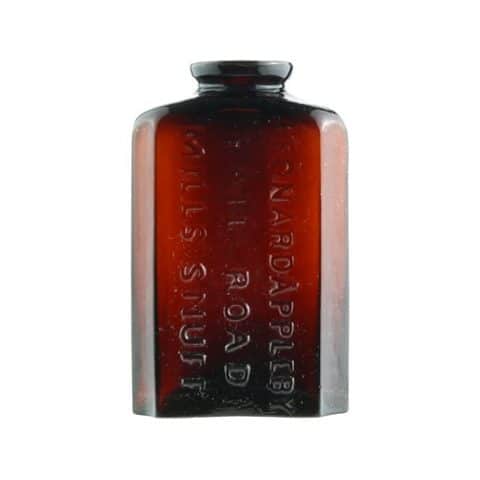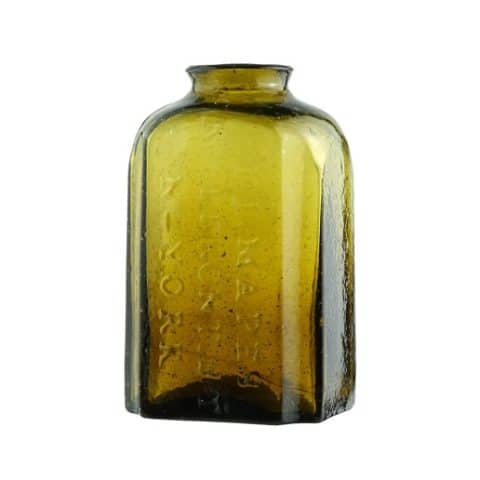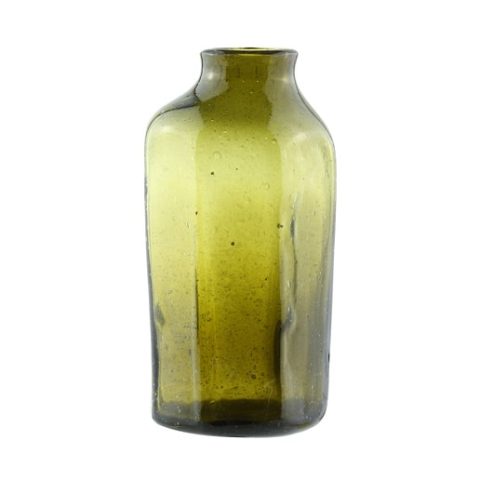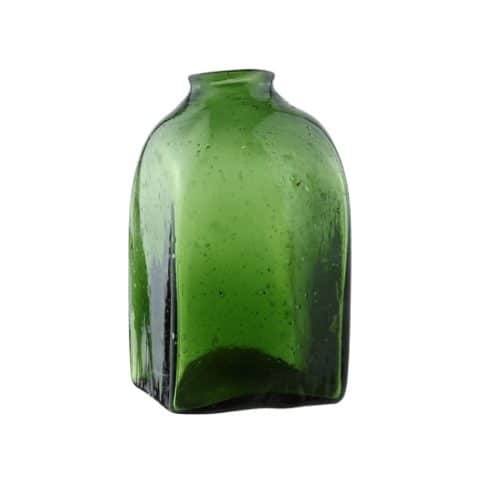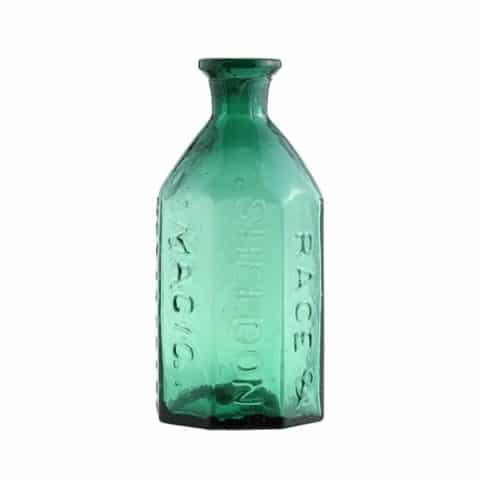Crocker’s Union Boot Polish Norwich Conn.
Crockers Union Boot Polish
Norwich Conn.
John Denison Crocker, Norwich, Connecticut
Medium Blue Green Blacking Bottle
Provenance: Michael George Collection

Our vibrant blue-green “Crockers Union Boot Polish Norwich Conn.” blacking bottle last sold in the Heckler #171 auction. The rare bottle can quickly be identified by the “Glass Works Auctions, Lot 232, The Mebane Collection” sticker on the bottom which is adjacent to the pronounced pontil scar. The bottle is 3-7/8″ tall by 1-7/8″ wide, square, has beveled corners, a short neck, and an outward rolled mouth. The blacking bottle could have been made at either the New London Glass Works or Willington Glass Works, both in Connecticut, from 1848 up to 1860 though it is uncertain.

John Denison Crocker
John Denison Crocker has been referred to as a Renaissance Man who excelled at many things. He was born in Salem, New London County, Connecticut on November 7, 1822, and spent most of his life in Norwich, Connecticut. At the age of nine, he was working for a wagon maker and by twelve he was apprenticed to a silversmith. He left that trade to work at the shop of a furniture maker and restorer. It was here that he was first exposed to restoration, varnishing, and art. When he was seventeen years old, John had an epiphany moment when a portrait was brought into the furniture shop for varnishing. The painting captivated him so much that he decided that his main purpose in life was to be an artist, specifically a portrait painter. He knew that he would also have to provide for himself to embark on this quest.

In 1847, at the age of 25, Crocker moved to New York. By 1848 or 1849, Crocker moved to Norwich, Connecticut where he married Harriet Elizabeth Dillaby on August 27, 1849. She was the daughter of Charles Dillaby and Harriet Derby, whose families were among the oldest in the town. They would go on and have eight children. Interestingly, the 1850 United States Federal Census listed John D. Crocker as a Daguerreotypist living in Norwich. The census also noted that their first child was just born, a daughter named after the mother.
Crocker, perhaps informed by a knowledge of herbs, pigments, and plant extracts, produced and distributed several well-received varnishes and coatings, including Crockers Union Boot Polish and Crocker’s Gum Elastic Self Polishing Blacking once he established himself in Norwich. An aquamarine Crocker’s Gum Elastic Blacking bottle is also represented in the gallery. He would continue developing varnishes and supplements for paintings throughout his life.
As an inventor, John D. Crocker worked on several valuable inventions such as a cork cutting machine and a file machine that were taken to market. In February 1870 and again in 1871 he patented a “Stretcher for Picture Frames.”
Later in life, in 1892, John D. Crocker developed and patented a cure-all called “Crocker’s Magical Stomach Powders,” the label of which doubled as a wrapper stating the philosophical, social, and political opinions of the manufacturer and guaranteeing that the contents would be “a sure cure for Indigestion and all Bowel Difficulties and Colds.”
The Slater Museum in Norwich, Connecticut archives include a letter dated July 19, 1899, from the British-born New York portrait painter Seymour J. Guy (1824-1910) that says, “The varnish or gloss applied by you to my two little pictures is as far as I am able to judge of it in this short time, an excellent article for artistic use, both as a varnish and as a painting vehicle. In a few days, it dries firmly with a desirable gloss, and the coloring of the picture is charmingly revivified. I shall not hesitate to use it for either of the above purposes.”
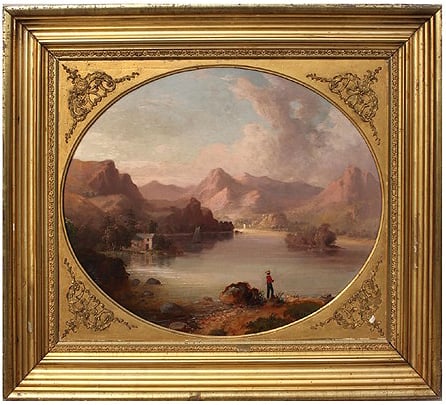
The Slater Museum is fortunate to have in its collection more than 40 paintings, most of them are oil on canvas, by John Denison Crocker that document the town’s late 19th-century golden age. Some depict captains of the city’s industrial revolution; some are portraits of people important to the development of the Norwich Free Academy, founded in 1854 and parent of the museum. Others are landscapes that document, with unparalleled clarity sweetened by affection, the original nine square miles of Norwich and its rural environs, dotted with the occasional textile mill or church steeple.
John D. Crocker would die on September 2, 1907, in Norwich, Connecticut at the age of 84 years old.
Primary Image: Crockers Union Boot Polish bottle imaged on location by Alan DeMaison, FOHBC Virtual Museum Midwest Studio
Support Image: Auction Lot 131: “Crockers / Union Boot Polish / Norwich Conn.” Blacking Bottle, possibly Willington Glass Works, West Willington, Connecticut, 1840-1860. Square with beveled corners, medium bluish-green, inward rolled mouth – pontil scar, ht. 3 7/8 inches, wdth. 1 7/8 inches; (pinpoint flake on edge of side panel). One of few known examples. Generally fine condition. Ex Robert Mebane collection, Michael Ray collection. – Norman Heckler Jr. & Sr., Norman C. Heckler & Company, Auction #171
Support Image: Auction Lot 73: “Crockers / Union Boot Polish / Norwich Conn.” Blacking Bottle, possibly New London Glass Works, New London, Connecticut, 1856-1860. Square with beveled corners, aquamarine, outward folded mouth – pontil scar, ht. 4 inches. A rare bottle with bold embossing and attractive whittled panels. Fine condition. Michael Ray collection. – Norman Heckler Jr. & Sr., Norman C. Heckler & Company, Auction #170
Support Image: Auction Lot 54: “Crocker’s / Gum Elastic / Self Polishing / Blacking” Bottle, probably New London Glass Works, New London, Connecticut, 1856-1860. Rectangular with beveled corners, aquamarine, inward rolled mouth – pontil scar, ht. 5 5/8 inches; (minor exterior high point wear and scratching). Rare and unusual. Fine condition. – Norman Heckler Jr. & Sr., Norman C. Heckler & Company, Auction #107
Support: Reference to John Denison Crocker: Norwich’s Renaissance Man by Vivian Zoe, Connecticut Explored Inc., Winter 2006/07
Join the FOHBC: The Virtual Museum is a project of the Federation of Historical Bottle Collectors (FOHBC). To become a member.








